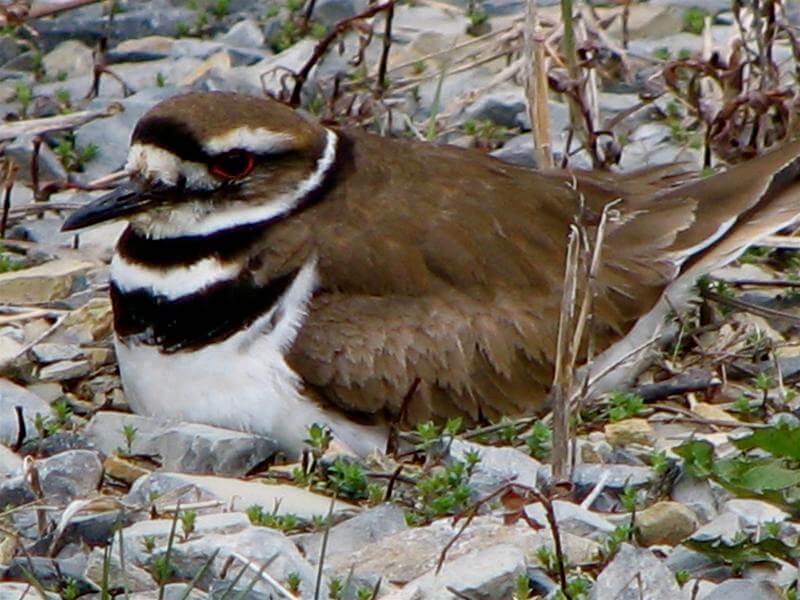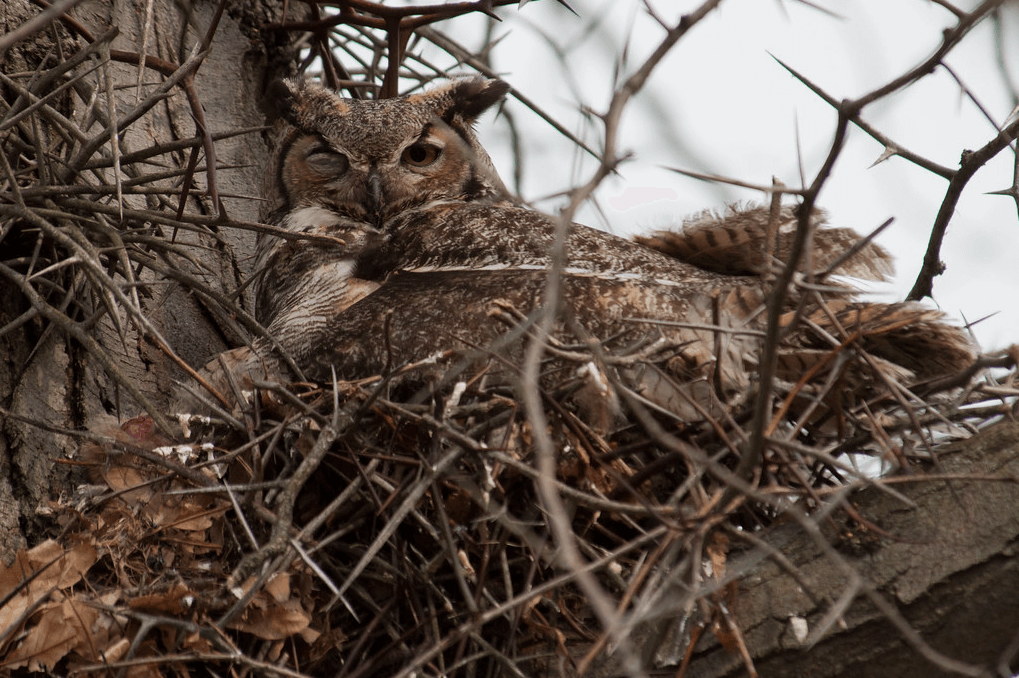Killdeer
by Karen Pogachar
Broadcast 4.28 & 5.1.2020

Female Killdeer on nest. Photo by Flickr user Audrey (CC 2.0).
Listen:
While glancing out my window the other day, I noticed a killdeer in my neighbor’s unpaved gravel driveway. I was reminded of the first time that I noticed a killdeer when I was a child. As I was walking up our gravel driveway, my attention was drawn to a killdeer in distress. The bird appeared to have a broken wing. Insistently and loudly repeating its name in call, it staggered forward, hugging the ground, with one of its wings distended as if broken.
Hoping to capture this bird and transport it to a veterinarian so that is wing could be mended, I followed. Keeping about three yards ahead of my child-sized steps and outstretched arms, the bird resisted my attempts, continuing to drag its wing while calling “Killdeer, killdeer, killdeer.” Eventually, I followed the bird down the road. Finally, as I reached to pick it up, it flew into the air, only to return to the driveway. I had been tricked by a superb thespian—this bird did not have a broken wing! Instead, it was protecting its nest.
About the size of a robin, the killdeer is striking in appearance. Grayish-brown above and white below, the adult has two black neck bands, the juvenile only one. The rusty orange on their upper tail and lower back is particularly evident while flying or performing the “broken wing” display.
Unlike many birds, a killdeer builds its nest on the ground. In order to protect the nest and young, a killdeer will build in an area resembling the buff-colored and spotted eggs, making graveled driveways and open dried fields prime locations for nest sites. (Or, in one case, the end zone.)
Once the nest is built and the eggs are laid, both parents incubate and care for the young. Since killdeer build their nests on the ground, it could be disastrous if the young were left unattended for any length of time. Typically one parent seeks food while the other incubates the eggs. Protection is provided by the parent remaining with the nest. When a predator approaches, the adult at the nest will distract it by displaying a broken wing and crying “Killdeer!” repeatedly. Thus distracted, the predator is lured away from the nest area until the killdeer no longer senses an immediate danger. Once this accomplished, the killdeer takes to flight, returning to its nest.
I no longer feel sorry for the bird feigning a broken wing like I did so many years ago. Instead, I have developed a sense of awe and respect for the killdeer. Whenever I am out walking in the fields, or through graveled driveways, and see a killdeer with a “broken wing,” I become cautious and take a different path to my destination so as not to disturb the killdeer and its young.
The next time you are taking a walk and see killdeer displaying a broken wing, do not be followed. Instead, recognize that a nest is nearby, and choose an alternate route.
Every week since 1991, Field Notes has inquired about Montana’s natural history. Field Notes are written by naturalists, students, and listeners about the puzzle-tree bark, eagle talons, woolly aphids, and giant puffballs of Western, Central and Southwestern Montana and aired weekly on Montana Public Radio.
Click here to read and listen to more Field Notes. Field Notes is available as a podcast! Subscribe on iTunes, Google Play, or wherever you listen to podcasts.
Interested in writing a Field Note? Contact Allison De Jong, Field Notes editor, at adejong [at] montananaturalist [dot] org or 406.327.0405.
Want to learn more about our programs as well as fun natural history facts and seasonal phenology? Sign up for our e-newsletter! You can also become a member and get discounts on our programs as well as free reciprocal admission to 300+ science centers in North America!












